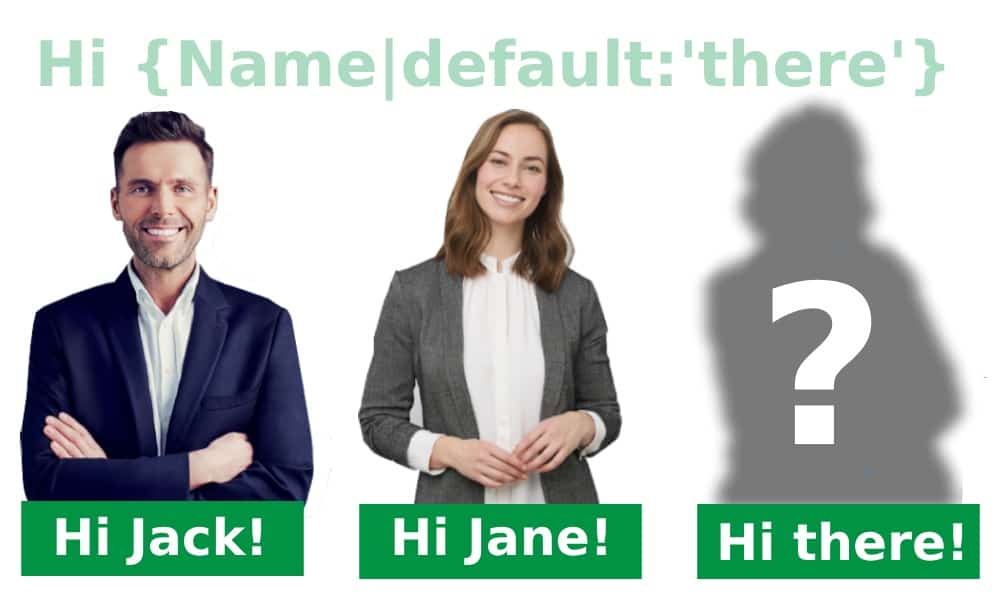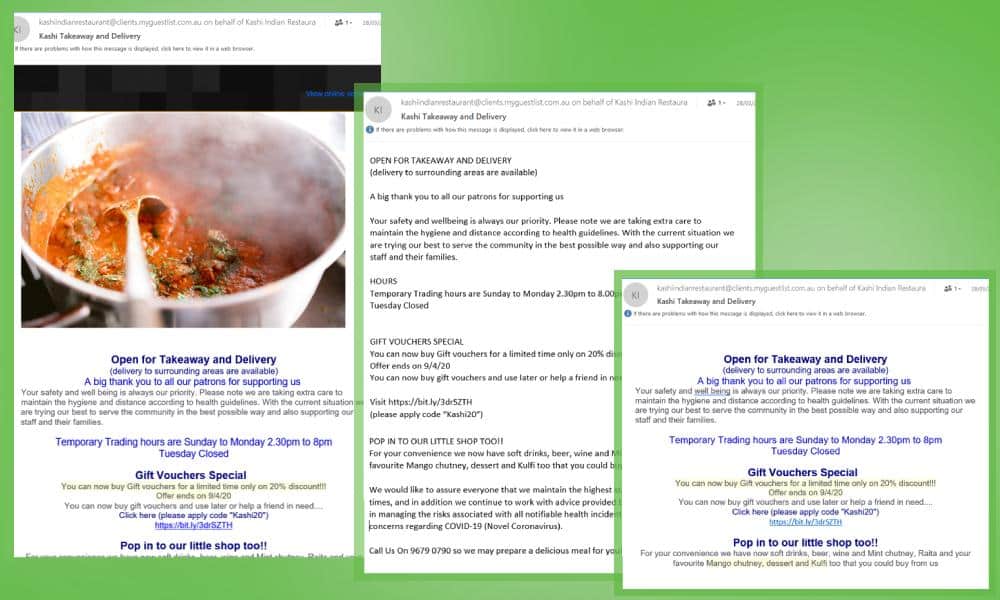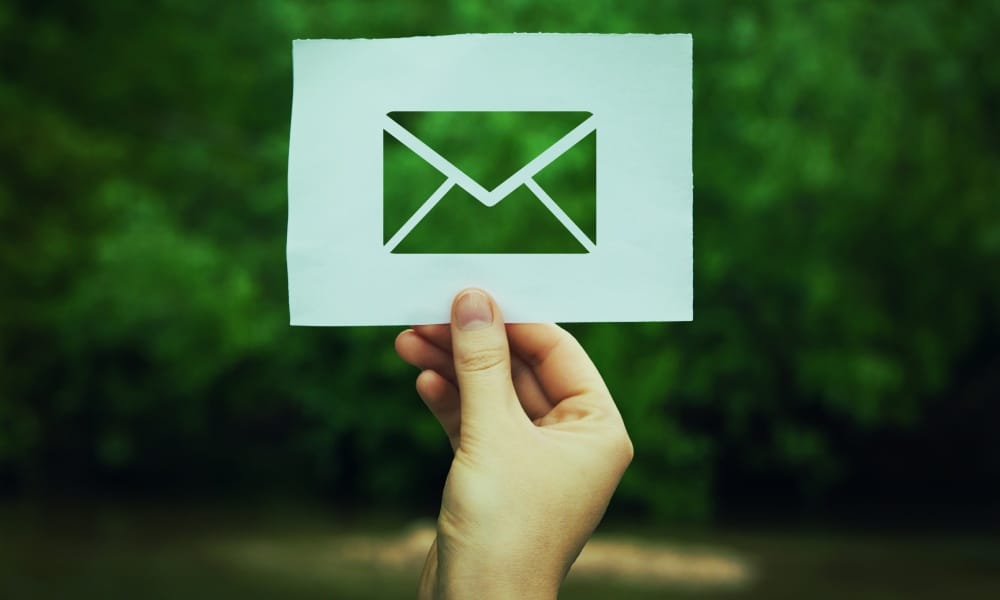If you’ve done just a little marketing – or even if you’ve had other people market to you – you’ll have come across personalisation. All those emails which open with ‘Hi Bridget‘. Occasionally ones which open with ‘Hi {first_name}‘. (Oops!)
But knowing someone’s name is just the beginning. There’s so much more to explore.
Today I’m sharing some personalised email marketing examples to inspire you – and also some thoughts about how to get personalisation right.
But there’s one thing I want to cover before we dive in.
Segmentation vs personalisation
Segmentation is a great marketing tool. When you only send emails to the most relevant people, the recipients are more interested. Open rates, click rates and enquiry rates go up. But be aware that you don’t necessarily get more opens, clicks or enquiries overall – remember, you’re sending to fewer people! In reality, the benefits of segmentation lie elsewhere.
- Since you’re writing for a specific segment, you can write more specific copy. This is where you can get lift in engagement rates.
- You don’t burn people by emailing lots of irrelevant stuff. So you have fewer unsubscribes.
- Platforms such as Gmail track open rates of your bulk email. Segmented email marketing means higher open rates, so your email is less likely to end up in the ‘Promotions’ tab and more likely to be in the ‘Primary’ tab where it gets seen.
This is all stuff you should do, but it’s not what I mean by personalisation. Both strategies depend on collecting data about your clients, prospects and contacts, but where segmentation sorts people into categories, personalisation gathers information about them as individuals. It’s the difference between knowing your contact works in the construction space, or knowing the name of their company.
Personalised email marketing examples
When it comes to personalisation, there are two limits – your imagination and the data you have available. Let’s start simple.
Address people by their name
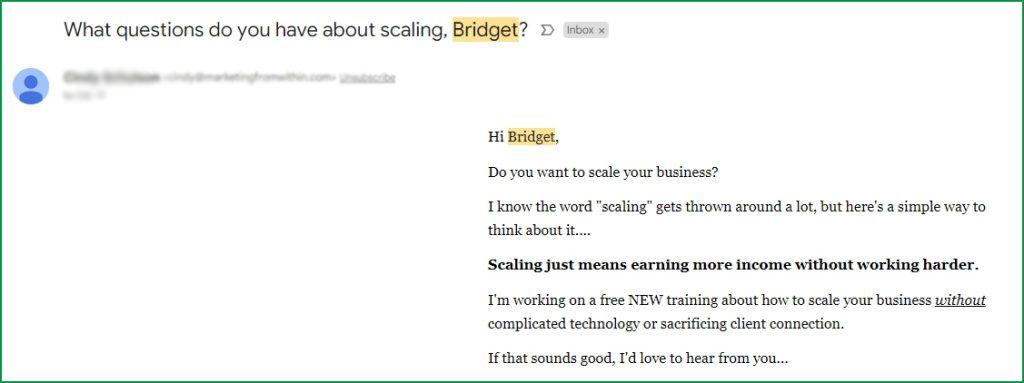
Personalising an email using first names is the easiest way to start. One research project (based on over a million emails) found that including the recipient’s name in the subject line
- increased open rates by 6 – 23%
- increased clicks by 7 – 32%
- reduced unsubscribes by 11 – 17%
You can also include the first name as a greeting in the email body. This is probably the most common personalised email example of all. But does it work? If that’s the only personalisation you do, it may be ineffective. Unless you mess up and send out the infamous ‘Hi {first_name}’ mentioned above, in which case it may backfire.
You’ll make more impact by using the first name elsewhere in the body of your email. It’s the same principle that politicians use during interviews. Using the interviewer’s name a few times makes them appear friendlier. (Unless you overdo it, in which case it makes you appear slimy or manipulative!)
More than just name-calling
One step up from this is to use your contact’s name as a part of the text.
Let them imagine themselves in a particular situation or story. It drives engagement and interest to a new level.
The person I know who’s best at this is Daniel Throssell. Here’s an example from an email which combines personalisation and ChatGPT in a hilarious way.

Now, Daniel has a way out-there style which may not suit you and your market. So here’s a simpler, more toned-down example of my own which may help bridge the gap.


One thing to notice is that both examples use more than just the first name. Daniel’s used a last name too. I’ve added in a last name and a company name. (I’m selling to businesses.) You can also see from my example that I’ve set up default values for each field just in case some data is missing.

Birthdays, anniversaries and beyond
The second most popular personalised email is probably the birthday offer. Restaurants and cafes use this all the time to generate extra visits. E-commerce stores do the same thing. There’s usually a ‘gift’ offer attached – a free bottle of wine, a discount voucher or so on.
How does that work for services and business-to-business? Often, it’s not so much the contact’s birthday which matters as an anniversary. For example:
It’s been a year [6 months / 3 years] since your last termite inspection [we serviced your vehicle / we installed your air conditioning]. Book in a time which suits you and we’ll check everything’s OK.
This model works for all kinds of services, both B2B and B2C and can really help increase the average value of a customer. To make it work really well:
- Consider an online booking link to make response easy and save you time. (You can still call to follow up on people who don’t respond to the email.)
- Include reasons for them to act on your suggestion. A termite inspection could save you thousands in damage. Servicing your car helps keep you and your loved ones safe. Cleaning air filters will make your aircon more efficient so you save on power bills.
- Emails to actual clients and customers should use their names, so make sure you add that in right at the beginning.
Other ‘different’ ideas:
- Some industries have lots of customers who are buying gifts for other people. Florists. Jewellers. There are services out there which act as birthday reminders. If that’s part of your business, can you try to own the customer instead of leaving it to them? Record gift recipients’ names and birthdays (or anniversaries), then email the gift buyer a reminder next year with that information in it.
I did this with one client. FYI it’s a lot easier with a customisable CRM than with a standalone email platform.
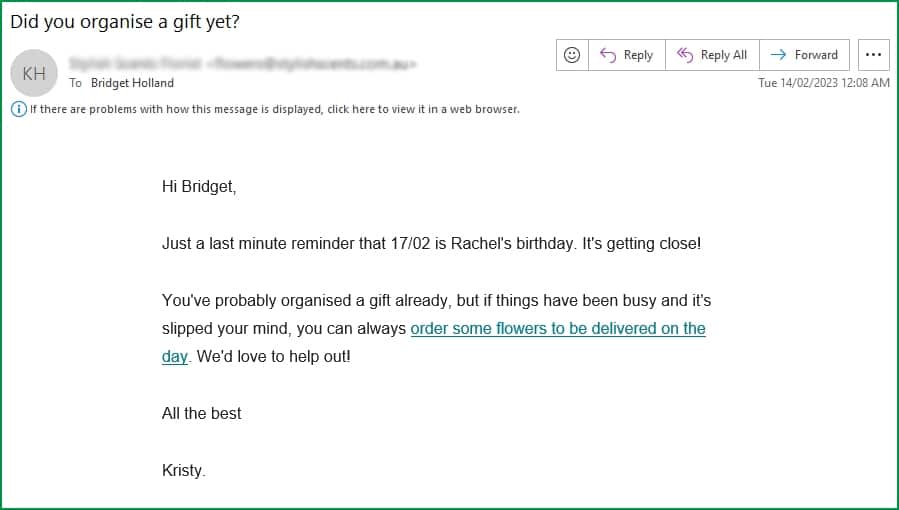
- Use birthday data to identify contacts’ star signs and send an email based on that.‘Where did all your money go? Astrologers would guess that as a Pisces, you gave too much away to charity and forgot to look after yourself and your business first. But I’m not an astrologer, I’m a money expert. I’ll look at you individually and give you the advice you need to get on top of your cashflow…’
(This requires a certain brand style, of course! And I wouldn’t recommend doing it too often. Maybe slot it in once a year around the silly season so it’s more tongue-in-cheek?)
From merge fields to dynamic content
Based on that last example, it’s time to introduce the idea of ‘dynamic content’. Specifically, dynamic content blocks which are sent only to contacts who fit certain criteria.
Dynamic content blocks sit right at the intersection of segmentation and personalisation. Instead of sending different email blasts to different segments, you send one email blast to everyone, but each contact only gets the blocks which are right for them.
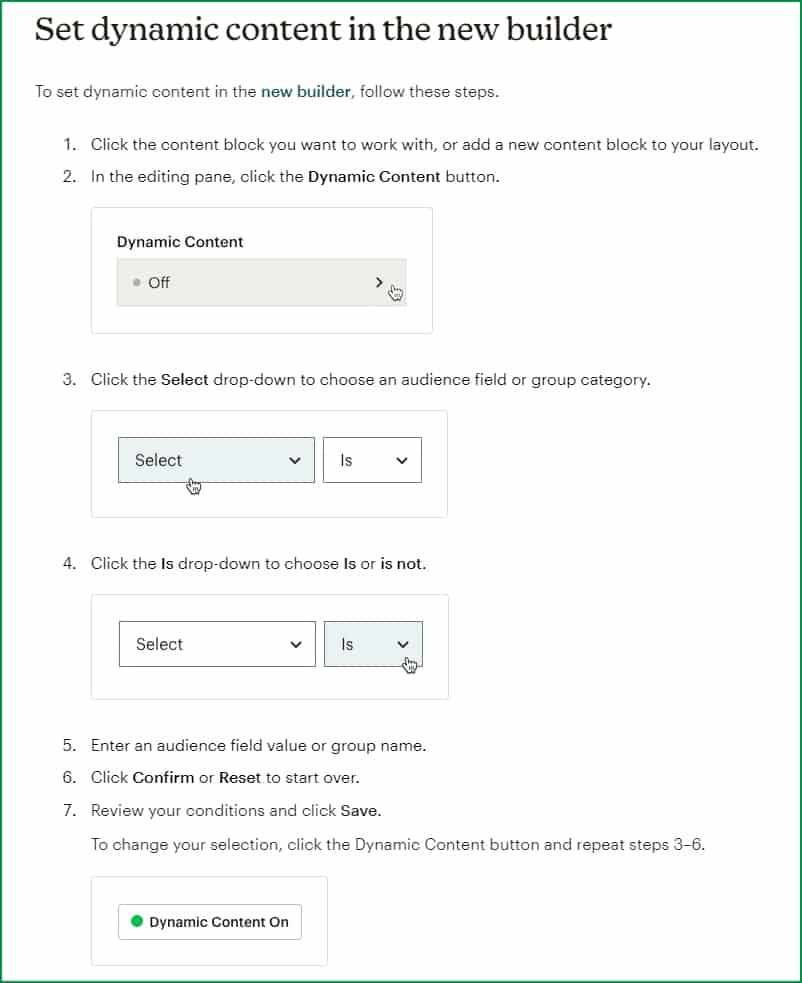
Why would you do this?
- You save time by setting up and sending one campaign only.
- You get reporting across your entire list rather than segment by segment.
There are some scenarios where dynamic content blocks really come into their own.
Overlapping segments
For example, imagine you’re a legal firm specialising in commercial law, employment law and intellectual property law. You send a monthly newsletter with updates in all three areas. Any individual contact might be interested in one of those areas, two of them, or all three. There are seven different potential combinations of interest areas.
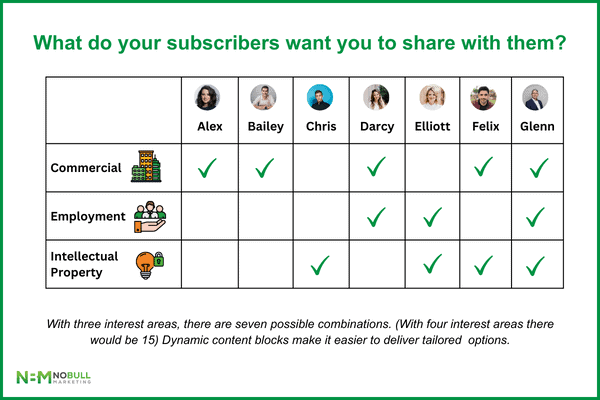
Without dynamic content blocks, personalised email marketing would require up to seven different emails, one for each of those combinations.
With dynamic content blocks, you can send everyone exactly what they’ve asked for, all in just one email campaign.
Separate messaging for clients and prospects
Imagine you’re a smaller business sending one email newsletter to both clients and prospects. You’re raising prices, but you’re going to give existing clients an extra 3 months at your current prices. (One of our tips for communicating price increases in a way which doesn’t lose you clients.) You can use different dynamic content blocks to communicate in very different ways – saying thank you to existing clients, while pushing prospects to act now and lock in lower prices.)
That’s exactly what we did at NoBull Marketing when we raised prices for the first time in 3 years.
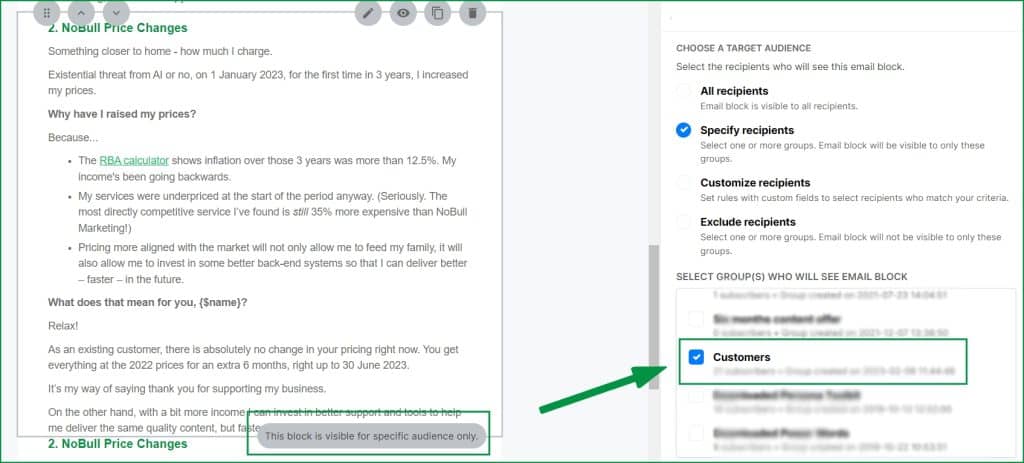
Other scenarios where you might want to use dynamic content blocks:
- You’re offering a special discount or added value to convert prospects into customers. You don’t want existing clients to know that others could get a better deal.
- You’re asking existing customers to give you a Google review. Include the block, but just for them.
- You’re running a customer survey and you don’t want non-customers to take it, but you don’t want to overload clients with too many emails. (Or you’ve already sent a survey email but want to include a reminder in the newsletter.)
- You’re planning interstate trips and you want to let prospects in each location know when you’ll be there in case they’d like to catch up.
- You target different industries – for example, you’re an event organiser working with charities and with corporates. You want to showcase your expertise with each prospect’s own industry by including relevant case studies, testimonials, tips or news updates.
How to make personalised email marketing work for you
By now, you should have a few ideas about how you could personalise your email marketing to fit your business. (If you don’t, let’s do a 15 minute brainstorm. No obligation!)
So what do you have to do to make it work in practice?
1. Get your data right
You can’t segment or personalise without data. And if you segment or personalise with poor quality data, you’ll get rubbish results. I’ve posted before about ways to collect data for segmentation – they work for personalisation just as well.
2. Always include default values
Some records will have incomplete data. That’s just the way life is. Not everyone fills in an optional field on a form. Not everyone answers surveys. Sometimes you have lots of contact records already and then you decide you need a new piece of information about them.
In all these scenarios, you need a default value, a phrase which makes sense when inserted into your text. Mailchimp uses the example ‘Friend‘ as an option for when you don’t know the first name. Personally, I don’t like this. I don’t want emails from someone I don’t know which start off ‘Hi Friend’! So I prefer to use ‘there‘ – this means the email starts ‘Hi there‘, which suits my tone of voice. (If you have a more formal style, you could try ‘Reader‘.)
The greeting is relatively simple. If you’re using other fields, or using names in the text itself, you may have to be more creative. This screenshot shows the default values for that example from the NoBull Marketing newsletter.

3. Test properly
In most email marketing platforms, a test email doesn’t actually perform the merge action of personalisation. Instead, you’ll need to send a ‘real’ email to a group of test accounts. Adjust the data in these records manually. Send the email. Check you get the results you expect and want. Then and only then, send to your live list.
4. Don’t overdo it
If someone addresses you by name every other sentence, it feels like they’re trying too hard. Don’t personalise every paragraph. Maybe not even every email.
Most of all, beware of using data your contacts don’t know you’ve collected. That can make you look like a stalker, and that’s not the impression you want to make!
Which personalised email example did you like most? Which can you try out in your email communications?
Or are you still wondering where to begin? It is possible you don’t have the same passion for this kind of stuff that I do, after all! If you’re one of those people who thinks it’s a good idea but it sounds like a lot of work, then maybe we should chat about how I can help you make it happen.

